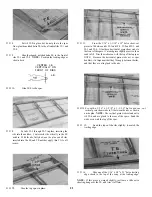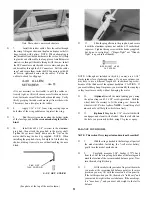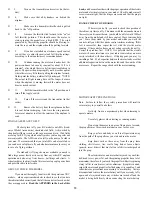
AMA SAFETY CODE
Read and abide by the following Academy of Model Aeronautics
Official Safety Code.
General:
1. I will not fly my model aircraft in competition or in the
presence of spectators until it has been proven to be airworthy by
having been previously successfully flight tested
2. I will not fly my model aircraft higher than approximately
400 feet within 3 miles of an airport without notifying the airport
operator I will give right of way to, and avoid flying in the
proximity of full scale aircraft Where necessary an observer shall
be utilized to supervise flying to avoid having models fly m the
proximity of full scale aircraft
3. Where established, I will abide by the safety rules for the
flying site I use, and I will not willfully and deliberately fly my
models in a careless, reckless and/or dangerous manner.
Radio Control:
1. I will have completed a successful radio equipment
ground check before the first flight of a new or repaired model.
2. I will not fly my model aircraft in the presence of
spectators until I become a qualified flyer, unless assisted by an
experienced helper
3. I will perform my initial turn after takeoff away from the
pit, spectator and parking areas, and I will not thereafter perform
maneuvers, flights of any sort or landing approaches over a pit,
spectator or parking area
FLYING
The ElectroStreak is a great flying sport airplane that flies
smoothly and predictably, yet is highly maneuverable It does not
have the self-recovery characteristics of a primary trainer,
therefore you must either have mastered the basics of R/C flying
or seek the assistance of a competent R/C pilot to help you with
your first flights.
The ElectroStreak will take off effortlessly from a hard-
surface runway (with landing gear installed), or with a short run and
a hand launch Always take off directly into the wind Immediately
after takeoff, fly level for a few seconds to allow the plane to get up
to speed, then climb gradually to maneuvering altitude.
We recommend that you take it easy with your Elec-
troStreak for the first several flights and gradually "get ac-
quainted" with this fantastic ship Add and practice one maneu-
ver at a time, learning how it behaves in each one We particularly
appreciate the low-drag feature of the ElectroStreak, which
allows it to "save" momentum efficiently from the previous
maneuver and use it in the next maneuver Snap rolls are
unbelievably quick and spins are also performed with ease.
Adjust the control surface throws according to your preference.
When it's time to land, make your approach low and
shallow, as this ship wants to just keep on flying If you find that
it lands a little fast, you might try dialing in a few clicks of up
elevator when you cut the throttle on the downwind leg of the
landing approach This will automatically help to bleed off some of
the speed Do not try to slow down too much, however, as doing so
may result in a stall If you are not using the landing gear, try to slow
the plane down as much as possible before touching down, and
(more importantly) concentrate on keeping the wings level to avoid
dragging a wmg tip.
Have a ball! But always stay m control and fly in a safe
manner.
APPENDIX
PROPER CARE OF YOUR GOLDFIRE MOTOR
Break-in: To properly break in, place a drop of oil on the motor
bearings and run the motor with no load (prop and prop hub
removed) for at least 1/2 hour when the motor is new, before using
it in your airplane
Power source: A 7-cell, 8.4 volt. 1200 mAh battery pack (with
"Kyosho"-type connector) is recommended as the ideal power
source for good power and long motor life However, for weight
savings and better vertical performance, you may use a 7 cell, 8 4
volt, 800 mAh battery pack.
Oiling: The bronze bearings are self lubricating, but you may
extend their life and improve motor performance by applying a very
small amount of light machine oil to the points where the center
shaft touches the bearings, after each hour of running time, or if the
bearings sound noisy Note A "drop" of oil is far too much, so you
should apply the oil with a toothpick Never oil the inside of the
motor!
Brushes: The Goldfire brushes (which transfer electricity to the
commutator inside the motor) are maintenance-free and will last a
long time under normal use You may inspect the brush wear by
looking through the vent holes on the sides of the motor When the
brushes wear out it is time to replace the motor If you notice that
your motor has lost power, but the brushes are still good, it will
provide a power boost if you spray some commutator cleaner (such
as "Reedy in a Can") on the brushes
Heat: Using multiple battery packs to run the Goldfire succes-
sive flights may cause the motor to become excessively hot
Therefore, we recommend a 10 minute "cool-down" period be-
tween flights (especially on hot days).
OVERLOADS
If the propeller is stalled, such as by running into long
grass or by "nosing over", and you do not shut off the power
immediately, the motor will draw a very large electrical current,
causing the fuse to "blow" or the overload protector in the electronic
speed control to trip.
34
Содержание Electro Streak
Страница 37: ...37 Use this three view drawing for planning your trim scheme...
Страница 38: ...NOTES 38...







































